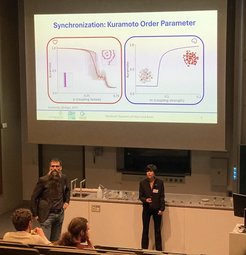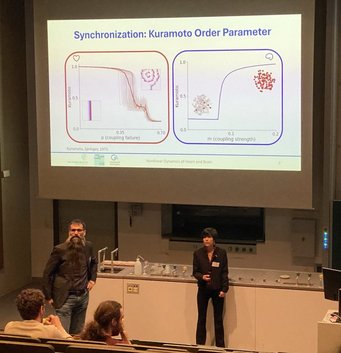Our PhD Candidate Irene on Her Lab Rotation
Before beginning their PhD thesis, our students complete two immersive three-month lab rotations in different Matter to Life research groups. This unique opportunity allows them to connect with faculty, explore diverse scientific approaches, and gain hands-on experience on a variety of methods, techniques, and projects across the MtL program.This model empowers students to make well-informed decisions about the direction of their research careers. Curious what it’s like? Read about Irene Pellini’s lab rotation experience— a doctoral candidate from our class of 2024.
Irene completed her lab rotations with MtL Fellows Wolfram Zimmermann (University of Göttingen & University Medical Center Göttingen) and David Zwicker (Max Planck Institute for Dynamics and Self-Organization, Göttingen), who collaborated to design the project she worked on.
Where did you do your lab rotations, why did you choose them in particular?

For my lab rotations, I decided to stay in Göttingen because I had fallen in love with the city during the first year of my Matter to Life journey. I also wanted to improve my computational skills by learning numerical techniques to simulate nonlinear, stochastic systems, and Göttingen offers unique scientific opportunities in this regard.
What was the aim of your project?
My project aimed to create a simple model that could simulate the collective dynamics of cardiac sheet and neuron populations with minimal changes. Both cardiomyocytes and neurons indeed have strikingly similar electrical dynamics, but the emergent signal at the organ level is very different – periodic and synchronized for the heart, irregular and asynchronous for the brain.
What were your main findings?
Thanks to the strong support of my colleagues, I was able to successfully build, simulate, and analyze the model at the end of the internship by using a mixture of established nonlinear dynamics tools and novel features. In addition, during the project, we identified other, more tangible applications of parts of our framework that could potentially lead to modeling real pathological cardiac conditions.
What was the biggest challenge during your lab rotation?
The road to success was far from smooth: I had to familiarize myself with a new programming framework and learn the basics of high-performance computing, which led to many frustrating moments when nothing seemed to be going in the right direction. Step by step, however, I was able to overcome all difficulties thanks to the help and kindness of my supervisors and coworkers.
What did you enjoy the most?
The aspect that I enjoyed the most in the past six months was the scientific and interpersonal interaction with my colleagues and supervisors, who were always there for me, whether it was to solve a problem with the project or to relax on the roof terrace of the Max Planck Institute for Dynamics and Self Organisation after a day of hard work. All in all, it was an insightful time where I was able to experience how top research groups collaborate, and exchange ideas.
